In this article, we will cover:
Evaluate Your L&D and Training Expenditures
According to the 2019 Training Industry Report1, the total U.S. training expenditures in 2019 declined by 5.3% to $83 billion compared to 2018.
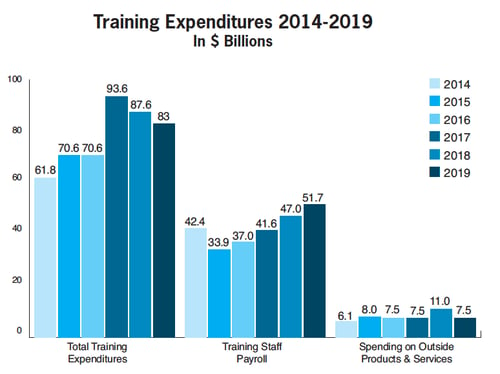
On average, spending on external products and services and other training-related expenditures (i.e., travel, facilities, equipment) show a combined drop of about 37.7% or $31.3 billion. Meanwhile, an average gain of 10%, or $51.7 billion, is shown in training payroll increases as a result of additional learning and development (L&D) staffing.
There is also a similar upward trend in human capital expenditures in terms of per employee L&D spending. In 2019, companies invested an average of approximately $1,286 per learner, compared to $986 in 2018.
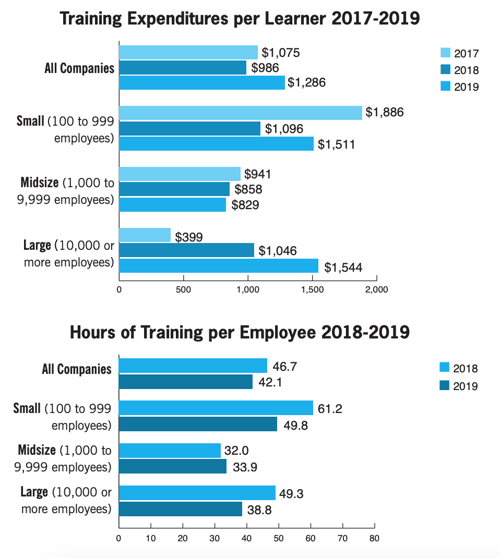
However, the report also shows that companies provided fewer hours of training in 2019. On average, employees received 42.1 hours of training per year, compared to 46.7 hours in the previous year.
Looking at the fluctuations in the statistical trends over the years, it is clear that organizations continue to be challenged with determining where their L&D budget can be wisely leveraged. While some of the shift in investment into human capital indicates a step in the right direction, unless we step back to fully understand and define the quantitative impact of our training initiatives on our organization, the guess work in strategic allocation of funds will continue.
We can all agree that $83 billion is a staggering amount of money. If it makes it easier for you, let’s make it more concrete and consider how much your company spends annually on its learning and development program.
Let us simplify our calculation and exclude all technology and equipment purchases, and factor only training costs (both internal and/or outsourced development or licensing costs; other costs associated with training such as travel, accommodations, etc; average employees spend learning AND the average monetary costs associated in training).
Once you have your number, calculate what is 80% of it in dollars. Unfortunately, the number you have represents what could be your annual employee L&D investment loss.

A frightening reality check, right?
On a scale from 1 to 5, rate the following to determine where your training investment may be going to waste, and see how you should focus your efforts to deliver engaging and impactful training programs in your organization.
Question 1. How would you rate your organization’s post-training reinforcement activities to ensure effective training transfer? Examples are:
- Trainee’s manager or supervisor is involved in providing opportunities to practice or demonstrate new skills and knowledge on the job.
- The trainee discusses performance objectives and action plans with their manager or supervisor.
- Employees have a forum through which to discuss work-related ideas and problems.
|
1: Don’t Know
|
2: Rather Not Say
|
3: Needs Improvement
|
4: It Works
|
5: Leader of the Pack
|
If you rated your organization’s post-training training reinforcement 4 or under, you are not alone. It is actually more common than you think. Without diminishing the effectiveness of the instructional strategies used by the learning and development professionals in your training programs, their effectiveness can only go so far as the learner’s ability to apply on the job training in the workplace.
According to a study by Dr. Brent Peterson at Columbia University, a typical company invests as much as 85% on the training event itself where only 10% of the learning actually takes place. Additionally, only 5% is invested in post-training activities where 70% of the actual learning takes place.
Do you think your organization is "Investing Too Much Effort in Low Yield Activities”?
In a hurry? Take it to go! Download the PDF version of this guide.
Question 2. How do employees perceive the importance or relevance of the training they receive relative to their job or in contributing to the success of the organization?
|
1: Don’t Know
|
2: Rather Not Say
|
3: Needs Improvement
|
4: It Works
|
5: Leader of the Pack
|
If you rated how employees perceive the importance or relevance of the training they receive 4 or under, it is important to make sure to communicate before and during the training what the benefits are of the training, i.e., how will it help them on the job, improve their performance, the training’s relevance to the business unit, etc. Essentially, you are addressing a key motivational question: “What is in it for me?”. This is one of the key employee training strategies that has proven to be effective in increasing engagement and motivation.
Engaging learners is a common concern in many organizations. Learner engagement is impacted when they do not see the relevance and impact of training in what they do on the job.
Perhaps you are “Not Addressing a Key Motivational Question: “What’s in it for me?”.
Question 3. What is the level of impact of your organization's learning and development programs on your organization’s strategic goals?
|
1: Don’t Know
|
2: Rather Not Say
|
3: Needs Improvement
|
4: It Works
|
5: Leader of the Pack
|
If you rated your organization’s learning and development impact 4 or under, and continue to use learner scores, course completion rates, and user feedback as the basis of training impact reports, you are not alone. It’s not for a lack of trying but rather gaps in the process that needs to be addressed.
There is a cost associated when leaders are indifferent to seeing the impact training has on the overall success of the organization. When training does not make much sense and perceived as having little to no value in the organization, employees become cynical, dissatisfied and disengaged. A recent survey indicates that 40% of employees who believe they receive poor job training leave their positions within the first year.
If there is little demand for L&D to be accountable and show real business impact data then there is a Lack of Confidence in the Impact of Training.
Question 4. How would you rate your organization’s culture in supporting their employees to continuously seek, share, and apply new knowledge and skills to improve individual and organizational performance?
|
1: Don’t Know
|
2: Rather Not Say
|
3: Needs Improvement
|
4: It Works
|
5: Leader of the Pack
|
If you rated your organization’s overall culture of learning to be 4 or under, this is a challenging situation that is all too common. It requires vigilance to convince company leadership that money well spent on workplace training and development requires an organization that supports the learning process from top to bottom. For this task research and statistics are your best means at communicating this necessary change.
If performance issues continue to persist in the workplace after training intervention has taken place is indicative that some of the basic behavioral principles have been overlooked, such as the competitive landscape, the processes, systems, politics, and on top of it – the culture. Research shows that the culture of the company is what will really determine the level of success of a training program. Leaders are where the learning culture starts. They’re the enforcers of the training initiatives and get the culture integrated into the workplace. They embody the change they want to see and have a responsibility to demonstrate the beliefs of the company and reinforce behaviors that reflect those values.
Lack of Leadership Support has been identified as the most common barrier to training isn’t applied on the job.
In a hurry? Take it to go! Download the PDF version of this guide.
Training or Learning in the Workplace: What’s the Difference?
There are three main reasons why organizations invest in training:
- to ensure that employees have the skills needed to do their jobs,
- to ensure that employees have the capabilities to support future business growth,
- to retain talented employees.
And like any investment, it must show gains if it is to be considered worthwhile. To fully understand how to maximize your organization’s employee training investments, it is worthwhile having clarity around learning and training.
While interrelated, these two terms are neither synonymous nor should be mistaken for the other. The confusion is understandable, We often see the interchangeable usage of training and learning in the context of organizational employee or professional development programs referring to them as either “Learning and Development” or “Training and Development”.
An effective employee development program must have both training and learning. And appreciating the distinction between the two will reveal a facet in workplace training initiatives that is often overlooked.
Training refers to the act of teaching a person; it is the action of imparting knowledge, skill or a type of behaviour. In the context of the workplace, it is an “event”, or a series of them, that spans time and can take months, weeks, days, hours, minutes, even seconds. It has many forms, delivery modes, and may be taken singly as a course (with one or many modules or units ), or in a series of courses.
One of the most common formats that many of us is familiar with is the face-to-face training. Typically it is delivered synchronously (in “real time”) in a classroom or virtually through a conferencing software.

Another common training type is the “self-paced” format. It is delivered asynchronously (not “real time”) through a software platform, e.g., a learning management system (LMS), and is “consumed” by the learner at their own time, place and pace. This mode may consist of one or many knowledge resources, in one or many media types (text, audio, video, etc), and with or without activities to do (quiz, homework, etc).
And of course there is the blended training format. This type of training is a combination of synchronous, asynchronous, virtual or on-site.
Learning is a process performed by an individual to collect and absorb new information with an aim of achieving an intended outcome. As individuals, we are responsible for our own learning; we drive the learning process, not the training.
Companies can offer and/or create training, provide training experiences and environments, but they cannot create the learning. They can only facilitate and nurture for learning to take place. And so, when we look at how we spend our training budget, it’s worthwhile considering what we do in our organization to support and foster the desire to learn and begin investing resources to get the learning process started.
Investing Too Much Effort in Low Yield Activities
Dr. Brent Peterson at Columbia University conducted a study comparing the amount of time spent developing training and related activities, and what actually contributes to learning effectiveness in the workplace. His research indicated that the typical organization invests 85% of its resources in the training event, a mere 5% on follow-up learning reinforcement activities.

However, his study shows that training events, in and of themselves, contributes only 24% to the actual learning process. Activities that drive learning effectiveness in the workplace are follow-up reinforcement activities after a training event. These are 50% more effective than the actual training event itself2.

In many organizations the typical training scenario is a simple input and output process that goes like this. Once learners complete the training, “success” is recognized by participation and a certificate or badge. The employee is then able to check the “complete” box and get back to work.
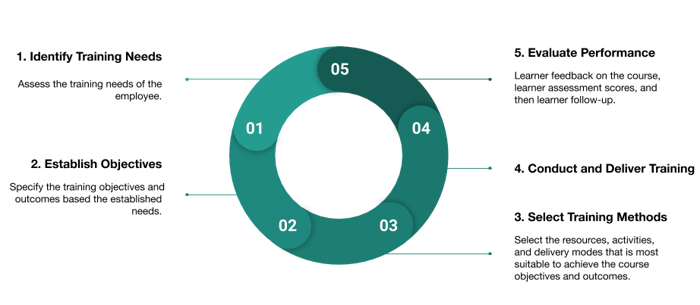
However, in the light of Dr. Peterson’s research, employees still require guidance and support to apply their new knowledge effectively. Unfortunately, this doesn’t happen in the classroom, it happens on the job, with regular, persistent coaching.
Participant Satisfaction IS NOT Learning Success
According to a 2019 study3, participant feedback, also known as “Happy Sheets”, still remains as the most commonly used type of evaluation method worldwide at 70%. And while there is some increased use of business relevant evaluation processes that offer valuable data to leadership such as manager feedback, actual versus budgeted training cost, and on-the-job behaviour metrics, their usage is but a fraction compared to the ubiquity of ‘happy sheets’ usage.
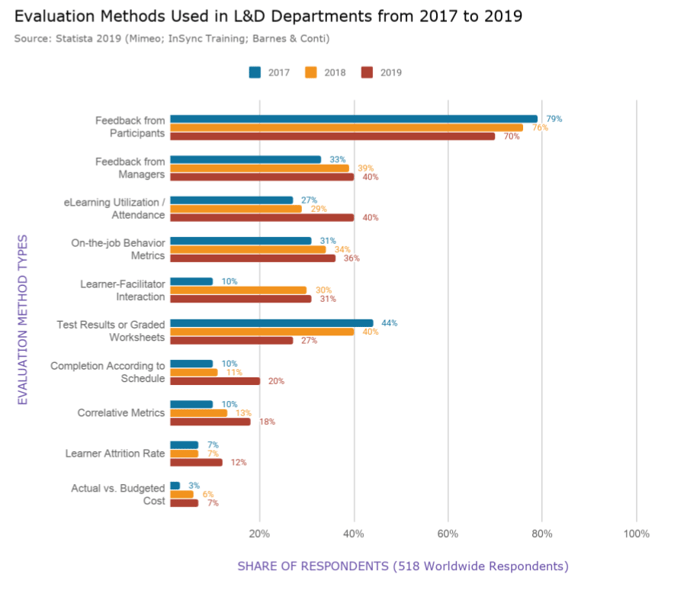 Understandably, participant feedback remains widely used because it is very easy to obtain, inexpensive to gather or to analyse for groups. It is also important to know that people were neither upset or disappointed with the training, and that people give a positive impression when relating their experience to others who might be deciding whether to experience the same.
Understandably, participant feedback remains widely used because it is very easy to obtain, inexpensive to gather or to analyse for groups. It is also important to know that people were neither upset or disappointed with the training, and that people give a positive impression when relating their experience to others who might be deciding whether to experience the same.
After all, studies have shown that “a positive reaction to training will carry over to the organization itself by way of increased employee commitment and reduced absenteeism, which in turn help to alter beliefs in regard to investment in training, encourage skills development practices, and alleviate the cost-benefit tensions that weigh on managers and staff in charge of training.”4
So, while there is room for subjective reaction measurements and may prove useful in making subsequent offerings more satisfying, they do not provide quantitative knowledge data and are no substitute for objective learning metrics: “evaluating training often exclusively with satisfaction surveys epitomizes the folly of hoping for competency development.”5 It is also important to note here that the pervasive use of satisfaction surveys is symptomatic that many organizations continue to perceive training as a “one-off” engagement.
Unfortunately, an organization’s continued inability to evaluate training effectiveness in driving business impact is that L&D initiatives will continue to erode itself as confidence in their effectiveness to deliver contributes further to their organizational perception as just another cost.
Two common misguided beliefs that many people still hold are:
1. Learning takes place during the training event.
2. Participant satisfaction and completion correlates with learning success.
Satisfaction ≠ Success
This is definitely far from being true. Relying on the “spray and pray” approach to workplace training and development is a major reason why training fails. To expect that whatever has been taught will magically get absorbed and applied in the workplace is mainly like “getting down on your knees as a leader and desperately wishing that the investment isn’t all for naught.”6
Accepting the tenet that offering a training course is enough to deliver positive outcomes and behavioural changes is really just relying on “hope for the best” as a learning strategy.
According to Sandy Almeida, MD, MPH, the correlation between taking a training course (Level 2: Learning) and expecting it to manifest itself naturally as behavior (Level 3: Behaviour) is not significant enough to make the assumption that learners will automatically apply what they have learned in training to the workplace.
Even if the training provided is exceptional, it does not necessarily follow that training transfer will occur and translate instantly to behavioral results rarely occurs without a good deal of deliberate and consistent reinforcement.
Without going into too much detail, the most-widely used method for evaluating learning success is the Kirkpatrick Model. This review-oriented methodology was first introduced in the 1950s by Donald Kirkpatrick, a former Professor Emeritus at the University of Wisconsin. Fundamentally the model consists of 4 progressive and interrelated levels to determine proficiency. Each successive level of the model represents a more precise measure of the effectiveness of a L&D program. Level 1: Reaction, Level 2: Learning, Level 3: Behavior, and Level 4: Evaluation. The process emphasizes that workplace learning should result in concrete behavioural and performance-related changes.
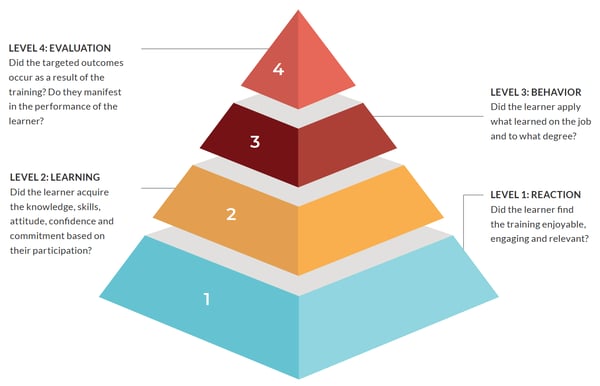
L&D professional design training modules based on sound instructional design principles and strategies, focusing their craft on the successful implementation of Levels 1 & 2. However, successful training transfer into Level 3 requires a structured approach of strategic on-the-job reinforcement activities involving the employees’ managers or supervisors. The actual transformative process of learning occurs primarily at Level 3 where managers have the greatest impact at supporting knowledge and skills application in the workplace.
In an ASTD study in 2006, the biggest reason for training failures comes after training is completed. The major factors identified were:
- the gap between the time employees learned and the opportunity to apply what they learned in the workplace, and
- the lack of follow-up and coaching.
In a hurry? Take it to go! Download the PDF version of this guide.
Use It or Lose it: The Forgetting Curve
The gap between learning and applying what has been learned is a crucial factor that affects training transfer. The forgetting curve, also referred to as memory decay, is a very well-documented phenomenon and starts almost immediately after consuming new knowledge.
The fact that we quickly forget what we learn is a biological imperative based on our innate, evolutionary desire for survival. According to research findings, “Conserving energy has been essential for humans’ survival, as it allowed us to be more efficient in searching for food and shelter, competing for sexual partners, and avoiding predators.”7 And so, our brains dispose of memories that we don’t use.

Forgetting is an all too familiar scenario where learners have returned from their course, and within days, they begin to forget important information and skills they learned during the training. The challenge of improving learner retention after leaving the classroom or any training event is an ongoing struggle for L&D professionals. People just tend to quickly forget new knowledge.
Memory retention is only at 100% at the moment of learning that particular piece of information. However, within the first 20 minutes, people will have forgotten an average of about 60% of consuming that information.
The phenomenon of memory decay was hypothesized and studied in 1885 by a German psychologist, Herman Ebbinghaus. Ebbinghaus discovered that the brain’s ability to retain information, memory, diminishes exponentially over time. More than half of memory loss occurs within the first hour, and most of the information is forgotten within the first 8 hours, then slowly steady out. Ebbinghaus’ discovery is typically summed up in what is commonly referred to as the Ebbinghaus Forgetting Curve.8
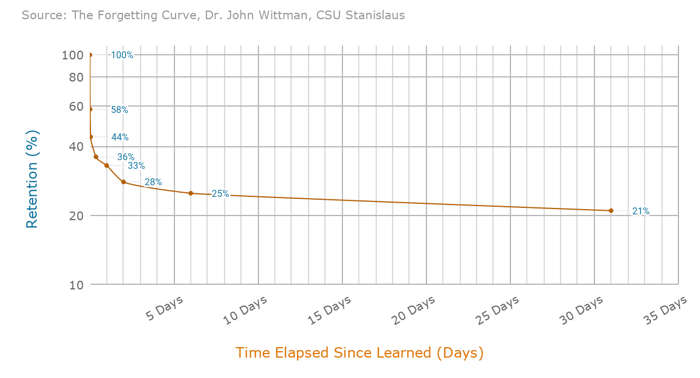
Various factors affect our rate of forgetting, the most obvious of which is the difference in memory performance between two different individuals. Other factors are:
- Meaningfulness of the information
- The way it is represented
- Environmental (noise, etc)
- Physiological (stress, sleep, etc)
However, when we factor in the billions of dollars businesses annually budget into training, and seeing about 70% of that budget forgotten in a single day is disconcerting.
As a result of memory decay, it is highly likely that your organization is spending more and seeing less in return. Looking beyond the financial impact of the phenomenon of forgetting, is the significant fallout on the purpose of training in the first place. In the case of workplace safety training, there is no underestimating the danger of forgetting 70% of what they have learned.
While forgetting is a natural process, it can be disrupted. Through simple processes, we can slow down forgetting and increase our ability to retain much of the information we need to recall at a later date. The two of the best methods Ebbinghaus recommends to increase strength of memory are:
- Better memory representation (mnemonic techniques such as short phrases, acronyms, etc).
- Repetition based on active recall (frequent spaced repetition).
He asserts that it is optimal for the first repetition to occur within 24-hours of the initial training.9 Information is easier to recall when it is built upon what is already known. Every time training is reinforced, the rate of memory decline is reduced.
Here are some instructional and active learning strategies you can apply as part of your employee training reinforcement structure.
Strategies to Reinforce Workplace Training
|
Mentoring and/or Coaching |
Any organization can benefit from coaching and mentoring as training doesn’t prepare learners for all the slight nuances that exist when trying to put training into practice. These empowering tools that contribute to a sense of social inclusion to a larger goal and the overall strategy of the company. The advantages for the organization are:
|
|
On the Job Training (OTJ) Experience |
On the job training experience is a great training reinforcement strategy as it creates a naturally occurring learning environment throughout the workday. OTJ provides experiential learning where the impact is real (as opposed to simulated) where the situation is taken seriously. |
|
Microlearning |
A study by the University of California found that in the modern workplace, employees tend to be interrupted every 15 minutes, on average. In this context, breaking learning content into smaller chunks, is a more preferable method of training over conventional long-format training courses. Microlearning can offer memorable, comprehensive content that will be better retained. Microlearning has the following advantages:
Additional Resources: Microlearning: What, Why, How, Where, and When? |
|
Active Learning Activities |
Active learning is the process of using activities such as reading, writing, discussion, or problem solving in an informal setting to promote analysis, synthesis, and evaluation of training content. The following are some active learning techniques that can be used in the workplace. Many more active learning techniques can be used and adapted.
|
The two most powerful opportunities for managerial input occur during the interaction with the learner prior to the training solution and after the training has been completed.
Managers Play A Critical Role In The Learning Process
While learning cultures start at the top, managers and supervisors are essential in its successful implementation. Managers must understand how important learning is to the company’s long-term future. It keeps their team members’ skills current, if not ahead of the curve. It also prepares employees for growth opportunities and improves employee retention.
Unfortunately, in many organizations, managers are not enabled to support most learning initiatives in the workplace. This is too bad as the constant interaction between manager and employee can be leveraged to improve training by consciously fostering a learning culture within the organization.
Typically, the level of involvement managers and/or supervisors have in the learning process of their team is simply to receive a summary of courses taken and the skills learned. While such reports may seem useful, they do little to help them gain insight on how they can assist their employees in applying what they have learned on the job.
Without management encouragement and support, participants will rarely implement new skills and knowledge in the workplace. This disassociation of managers from the training and evaluation processes hinder their active participation.
In organizations where managerial support is expected as part of the learning process, the problem exists in managers’ perceptions about reinforcement and support. Although some companies do require managers to conduct some physical activities such as pre- and post- training discussions, a greater proportion only require their managers to formally endorse a training program.10 And when managers do offer their encouragement and support, some feel that they should not have to probe further into each learner’s application of new skills or knowledge.
It is important for all involved in the implementation of training interventions that learning new skills is a different situation. When a new process is implemented in the workplace, particularly one involving a significant departure from previous approaches, the immediate manager’s support is required.

To help managers and supervisors transition to their new role as active agents in the learning process, they can to be supported in the following ways:
- Show them the importance of their role
- Help them understand the change needed, the role of change management on projects and initiatives, and their role in that change
- Allow them to voice their concerns and objections so they become supportive of the process
- Provide accurate and timely information so they can communicate with their direct reports (e.g. talking points, FAQ documents)
- Provide change management training on the roles, processes and tools for managers and supervisors
- Provide accurate and timely information as well as the tools they need to support their employee’s transitions
It is also important to clarify what is expected of them coaches and mentors through the development of management reinforcement modules defining managers’ support roles, conducting workshops to show their specific roles, holding them accountable through their own job descriptions and responsibilities, and rewarding them for doing it right.
When managers understand their role in how they can bolster new skills and behaviors, they will be better equipped in ensuring learners do not revert back to previous practices.
When managers are well-trained, studies show manager coaching positively impacting performance and employee engagement. The critical skills that managers need to coach effectively are:
- Provide specific and constructive behavioral feedback
- Use effective communication skills like listening and questioning
- Motivate and hold employees accountable for improvement
- Establish trust
- See different perspectives and show empathy
- Clarify employees’ roles and responsibilities
In a hurry? Take it to go! Download the PDF version of this guide.
Not Addressing the Motivation Question: “What’s in it for me?”

There are many factors that may affect an individual in transferring what has been learned in training to on-the-job behavior. While some of these have nothing to do with the training program as such, they should be considered during the evaluation process. Sensitivity to and recognition of these factors is useful when deciding on its training program effectiveness.
According to a study by Thomas P. Patterson11, we need to monitor the variables that influence training transfer prior to, during and after training, as the motivation to learn, perceptions of benefits, and work environment perceptions have a direct correlation with how much participants learned.
|
Pre-Training |
Participant motivation Self-efficacy Self-efficacy is an important factor in motivation going into a training program, such that individuals higher in self-efficacy are typically more motivated to engage in the training process and thus get more out of the training. Participant ‘Locus of Control’ (LOC)
Organizational climate
Likewise, organizational climate factors such as a learner’s perceived social support of the training program by supervisors and peers has been found to be positively linked to transfer of the techniques or knowledge learned in training. Framing of the training program |
|
During Training |
Meta-cognition Individual goal orientation
Learning goals are typically associated with higher learning achievements during training. L&D professionals should be mindful of these types of goal orientations and strive to influence learners to develop learning goals rather than performance goals. |
|
Post-Training |
Self-efficacy Organizational environment Equally important is the learner’s perceived social support of the training program by managers, supervisors and peers has been positively linked to transfer of the techniques or knowledge learned in training. If learners view that their colleagues do not value what they have learned, they often will not attempt to perform the new skills they have learned. |
The ultimate goal of corporate training initiatives is to impart knowledge and change behavior. And as the evaluation of training effectiveness is to give a precise estimate of the impact of a training program, it should take into account some of the learner characteristic variables that determine training transfer success.
Lack of Confidence in the Impact of Training
The positive correlation between investments into training and company’s bottom line results, have given organizational leaders the assurance that training costs are necessary and useful. However, without clear evidence tying training expenditures to company wins, organizational leadership’s confidence in L&D’s ability to deliver impactful training that meets business goals will continue to erode.
In many cases, company leaders become indifferent to requesting relevant data to show the correlation between training and company performance.

This apathy then trickles down the organization, as HR and L&D professionals do not feel the need to be accountable for hard business impact data beyond providing Level 1 reaction sheets and Level 2 learning data (enrollment numbers, completion rates, etc) as a means of showing value. The risk of remaining at this level is that it encourages “edutainment” over substance.
Apathy to truly understanding the level of learning effectiveness has other trickle down effects on employee engagement. Training participants who are not held accountable for their results fosters the idea that there are no social expectations shaping their behaviour in the organization, and that they have no need to share their information, data and knowledge with others.
When no one is responsible for results, employees go back to old habits and do things as they were done in the past. Consequently, this creates a perception of an environment that is unchangeable and where individuals have no control over their destiny. “Then it is highly likely that a negative attitude towards learning and knowledge in organizations will also exist.“12
When learning and creating knowledge do not make much sense and are perceived as having little to no value in the organization, employees become cynical, dissatisfied and disengaged. Once an employee becomes disenchanted, they don’t work as hard and less productive as those who are committed to the company.
A recent survey indicates that 40% of employees who receive poor job training leave their positions within the first year.13 Conversely, companies who rate high on employee training saw 53% lower employee attrition rate.14 Training is more than just teaching employees to do a job. It’s about engaging them with the company and showing them they matter through that engagement and investment. The ramifications of indifference towards training effectiveness, therefore, are far reaching than just training investment loss from unapplied and forgotten knowledge.
Read more about how you can Make a Great First Impression with a Solid New Hire Onboarding Program.
Make Training Evaluation Data Irresistible
One thing we need to accept in the onset is that there is a language barrier between business units within any organization. What metrics means to executives, means differently from L&D professionals, sales and marketing teams, safety and compliance officers, etc.
For L&D to be successful in getting the recognition they deserve from the organization, the respect at the C-table, and to get better training budgets, they must first find out what the rest of the business is measuring.
In fact, a Training Industry research has found that 95% of L&D professionals rate business acumen as an important competency for successful training managers.15 In the paper, The New HR Competencies: Business Partnering from the Outside-In, it states that HR (and L&D by extension) “that starts with the business, doesn’t get as much resistance from the business.” Furthermore “they need to think and act from the outside-in” and be “able to translate external business trends into internal decisions and actions.”16 So, how would you know where to begin in determining what to measure and how to use that data to communicate training’s business impact to stakeholders?
Start With Alignment: Begin From the End
The disconnect between management expectations and actual results comes from considering Levels 3 & 4 of Kirkpatrick’s evaluation steps after the training has been developed and delivered. The task of determining the business impact of training as an afterthought, while possible, is difficult and labour intensive.
While L&D focuses on training scores, course completions, learning retention, etc, the company is thinking about revenue, profit, customer satisfaction, cost per unit, compliance, and many other metrics. Your company has their own core business metrics and it is important to understand what they are, and why they matter.
The Kirkpatrick Evaluation Model has been formulated to show the business value and worth of training. So it is important to speak the language of the business to successfully undertake impact evaluation of your organization’s training programs. This will allow you to align your L&D metrics with key business metrics to understand how they influence each other. And while the Kirkpatrick Evaluation Model is widely known and utilized, it has also been misapplied, especially Level 4. Many follow the four levels linearly and start from level 1 and make their way through to level 4. However, if there is any chance for training programs to show any measurable business impact, it is essential to begin the process from the end, and add alignment as the first step of the measurement process.
The true aim of learning is to improve on-the-job performance and measurably contribute to organizational outcomes. Ask yourself: "How do I know programs are having the desired impact on the business, and to what degree?"
So, in order to achieve that, it makes sense to find out what the gaps are in those areas first. Work from the top down of the Kirkpatrick Model, starting at Level 4 and identify the results you want to achieve. Consider the top level metrics that capture the overall performance of your company: measurements like sales and earnings growth; quality; on-time delivery; product cost and safety are common examples.
Take care, however, to define the results holistically, as in how does it contribute to the success of both the department as well as the organization as a whole. The common misapplication in Level 4 is to define results only in the terms of functional areas of the company instead of for the entire organization. So you need to establish the linkages that tie these metrics to people activities and the incremental benefit or performance expected to result from the learning and development program.
In turn, these indicators become the Level 4 evaluation KSAs which can be converted into observable and measurable outcomes against which return on stakeholders expectations can be analyzed and reported. This is what is commonly known as Return on Expectations (ROE). It was developed by Dr Jim and Wendy Kirkpatrick as they clarified the Four Levels in the New World Kirkpatrick Model. ROE of any training is the ultimate indicator of value in the Kirkpatrick Model. Its value for any organization is premised on the fact the ROE is designed, developed and delivered in partnership with those business stakeholders who will determine learning’s value.
From there you work downward to Level 3 to think about what participants need to do on the job to achieve those results, and so on. L&D professionals “must begin with desired results and then determine what behavior is needed to accomplish them.”17 At this stage key stakeholders must be asked to clarify and refine their expectations to their satisfaction: “What does success look like to you?” By defining with stakeholders what success will look like upfront, you can more easily identify and benchmark key metrics before training is delivered, and make post-training results easier to evaluate right from the start and not as an afterthought.
Let’s illustrate how we can align L&D and business metrics with an example.
|
Background: Your company is deploying an enterprise-wide CRM solution to better manage its sales process from lead generation through to customer engagement and nurturing. Audience Profiles
Training Needs Assessment (TNA): The Sales Team needs training on the CRM solution. L&D develops the training to assist the Sales Team in achieving the required proficiency levels. Learning outcomes will be validated through assessments. Key Stakeholders Expectation: The Sales Executive expects that the new CRM solution will help Sales Associates spend less time in the creation of pipeline reports and more time and prospecting leads and engaging with clients. Creating reports takes approximately 1 hour per associate per day, and translates to 12.5% increase in time spent prospecting and engaging with clients. And this in turn has a proportionate impact on leads conversion. Looking at the TNA alone, we only see one set of metrics. Level 1 and Level 2. However, when you combine both business and L&D metrics, you can start asking the right questions (and give the right answers into evaluation Levels 3 & 4) that will give you the insights you need to create optimal business results. For example:
|
So, when we move backwards through the four levels in sequence, then we are able to create a “chain of evidence” with data from all four of the levels. The results can then show and support the value of the training investment provided to the business.
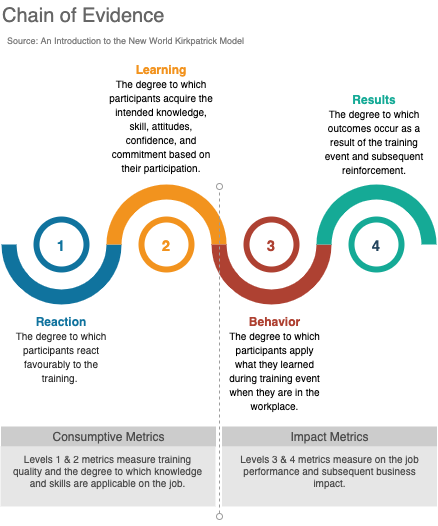 Levels 1 & 2 represent effective training metrics and offer qualitative data on program design and delivery. These measure training quality and the degree to which the knowledge and skills can be applied on the job.
Levels 1 & 2 represent effective training metrics and offer qualitative data on program design and delivery. These measure training quality and the degree to which the knowledge and skills can be applied on the job.
Evaluating the effectiveness of your workplace training program begins with translating L&D results into the language of business to make sure they are aligned. This is a challenging task and takes time to master. The key to your success in bridging the gap between learning and business impact through ROE is to partner with one of the business leaders in your organization. Bring your separate disciplines together, and ask them to help you understand how decisions about L&D impact their ability to achieve their business outcomes.
Another positive outcome of building training around organizational objectives and strategies is that trainees immediately see the connection between their new skills and where the organization is going. This makes training more relevant – and gets everyone focused on applying their new skills to the organization’s key priorities and goals.
In a hurry? Take it to go! Download the PDF version of this guide.
Make Sure the “Right People” are Involved
To get started on building ROE in your organization you need the “right people” to be involved. You need to identify the key stakeholders and their priorities to help define what successful training looks like and how well your training programs will specifically contribute to your organization’s most pressing business needs. The alignment between L&D and the business means working on the right programs, having line managers and executives committed to the programs, and making sure your learning, performance, and behavioural objectives are completely aligned with the objectives from the line of business.
According to Kirkpatrick, business partnership is essential in bringing about positive ROE. This alliance should consist of: HR, the L&D department (if distinct from HR), and the key stakeholder, management; specifically, the manager with the training need. The latter is essential in this process in order to determine what success means and define their expectations. It is the responsibility of managers to ensure that they’re employees are able to meet their current job requirements as well as be prepared for any upcoming changes that might occur. Moreover, it is the learner’s manager who has the most impact in the application and usage of what has been learned on the job through active post-training, which is crucial to achieving real behavioral and performance improvements. Research shows that learning transfer increases at least 40% with management involvement in learning.18 There are 2 factors that contribute to this increase. Firstly, managers have direct first-hand insight on the needs of the employees on their team. Secondly, they are able to leverage training benefits when they have input into which skills are developed.
However, the collaborative effort between L&D and key stakeholders must extend beyond just the identification of knowledge, skills and attitudes (KSA) or key performance indicators (KPI). There are many benefits to involving managers throughout the learning and performance processes. By focusing learning evaluation on the reporting needs of managers, they get what they need. This also enables them to be accountable for taking action in achieving impact evaluations. As a result, managers are in a better position to reinforce and coach new skills, thereby increasing the amount of learning that is applied and used in the workplace. Moreover, when managers have first-hand knowledge and understanding of the training program and evaluation processes, they are better equipped to motivate their employees and discuss what is being learned. Additionally, this helps build their credibility to their team.
At this stage, it is important to make sure you set expectations upfront with stakeholders. Help them understand the commitment required to see the assessment processes through to the end. Making sure you communicate with them frequently ensures that the data you provide remains relevant, credible and valid. This will reduce resistance encountered during the measurement phase.
Lack of Leadership Support
A successful deployment of training intervention needs more than just aligning training goals to business objectives. For training initiatives to achieve their intended outcomes, they need an environment where learning is cultivated and supported.
It is a common misconception that employee performance can be improved when we teach them the knowledge, skills, and attitudes to become an effective team member. Consequently, when the individual’s behaviour changes, it will affect organizational behaviour changes as well. This puts an enormous amount of pressure on the learner as the sole author of performance, positive or negative.
However, if performance issues continue to persist in the workplace after training intervention has taken place is indicative that some of the basic behavioral principles have been overlooked, such as the competitive landscape, the processes, systems, politics, and on top of it – the culture. In fact, one of the most commonly cited barriers to transfer of training to the job is the culture in the work group does not support the training.

Learning is a Social Process: Build a Culture of Learning
According to the research of Nebojša Janićijević on the Impact of Organizational Culture on Organizational Learning and Knowledge Management, the culture of the company is what really determines the level of success of a training program.
This is further corroborated Josh Bersin pointing to a strong connection between a robust learning culture and higher employee engagement rates. Companies that implemented a modern learning culture experienced 30%-50% higher engagement rates with higher productivity levels and more likeliness to develop innovative products.19
What is a learning culture? It is a culture in which employees continuously seek, share, and apply new knowledge and skills to improve individual and organizational performance. A culture of learning cultivates a “growth mindset”.
It is characterized by close alignment between business and learning strategies, with organizational values that affirm the importance of learning, and employees are encouraged to seek out new opportunities to learn from one another and contribute to the mission of the organization.
To build a strong learning culture, it’s important that employees are shown how important their work is to achieve organizational success. That’s why it’s important for L&D professionals to align learning objectives with business objectives when introducing a new learning experience. Learning is a social process.
Learning is effective in an organization when individuals work together rather than just learning in isolation. Shared learning enables companies with an enhanced ability to adapt to change, easier transition to succession, and have a skilled workforce with a strong sense of ownership and accountability.
Companies must shed the notion that learning is achieved solely through participation in knowledge acquisition activities via training events and engagements.
The notion that training is an event or a series of events is still a common belief in many organizations. This view perpetuates the idea that workplace or corporate learning is the same as academic learning, or that training is synonymous with teaching.
While it is true that both apply the principles of knowledge transfer that are important to long-term employee development, it is incorrect to consider training and teaching as identical. Teaching is the process of imparting knowledge. Its focus is directed inward toward the individual.
Training, on the other hand, extends beyond the acquisition of knowledge and information. It is focussed on the development of skills, that is, the practical application of knowledge needed to successfully undertake the duties that make up the occupation. Training has an outward focus associated with social expectations, namely, its ultimate outcome is to impact business performance and success.
Training therefore is more than just a “teaching” engagement that ends when the event is over. It needs to be applied on the job to be successful. Training that produces tangible results starts by changing behavior – which ultimately changes attitudes.
So, when learning a skill, the traditional notion of acquiring knowledge won’t work because it needs the adoption of new habits and routines. And as skills, in turn, are made up of behaviours, they need to be deliberately reinforced. Studies continue to show that between 60% and 90% of what is learned in training isn’t applied on the job.20 There are many reasons this occurs, but the “lack of management support” has been identified as the most common barrier.21
Leaders Are Top Contributors of Success
Leaders are where the learning culture starts. They’re the enforcers of the training initiatives and get the culture integrated into the workplace. They embody the change they want to see and have a responsibility to demonstrate the beliefs of the company and reinforce behaviours that reflect those values. Leaders express and demonstrate an interest in employee growth, and therefore must drive a thirst for continuous learning.
 Changes that need to impact the entire organization are driven by executives and senior leaders. Senior leaders provide the authority and credibility necessary for successful change. An organization looks to its leaders to be visible proponents of change and to demonstrate why it is necessary.
Changes that need to impact the entire organization are driven by executives and senior leaders. Senior leaders provide the authority and credibility necessary for successful change. An organization looks to its leaders to be visible proponents of change and to demonstrate why it is necessary.
As change agents, senior leaders, are the top contributors of change. However they are also the primary obstacle to its success. When change sponsorship is ineffective, it results in more resistance and slower progress towards realizing the organization’s desired results.
According to the Best Practices in Change Management study, change sponsors who were inactive or invisible, not at the right level, not aligning other leaders around the change, and wavering in their support, were reasons identified as obstacles to success.
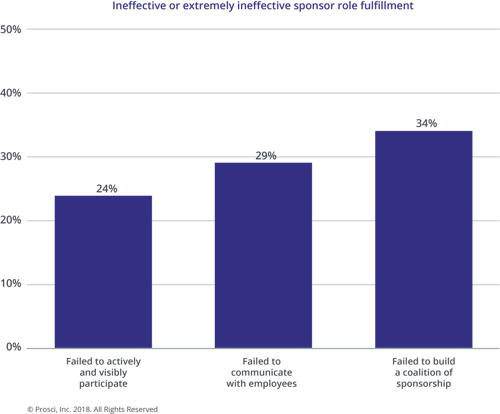
The Best Practices in Change Management study shows that most senior leaders were easy to engage in the role of sponsor. Over one-third were proactive and enthusiastic about sponsoring change and nearly 40% were ready to do what was asked.22 Only one-quarter of participants indicated some hesitation, resistance or indifference from their sponsor. However, the study also indicates that many did not understand what sponsorship meant.
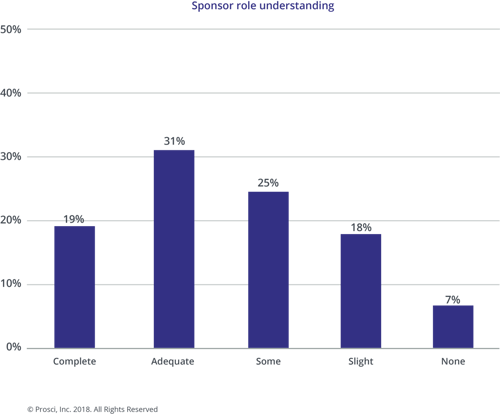
Executives and senior leaders need to understand their transformative impact on creating learning culture. As sponsors of change, they need to:
-
Be committed and participate visibly throughout the project. Sponsorship is more than allocating the necessary funding and then disappearing after the kickoff meeting. They need to participate in change activities. Their consistent involvement is necessary to build and maintain momentum for a change.
-
Communicate support and promote change. It is important for employees impacted by change to hear about the business reasons for change, as well as the risks or costs of not changing from senior leaders of their organization. Direct engagement with impacted employees prioritizes and legitimizes the need for change within the organization. Moreover addressing and encouraging the employees directly shows they are being recognized. The message also sets the tone for importance and the need for personal accountability.
-
Build a strong partnership of support. The sponsor must engage other key business leaders and stakeholders so they can advocate for the change and legitimize it in their part of the organization. Building an alliance of sponsorship also means managing resistance with their peers. This is especially important for changes that impact multiple functions within the organization.
Conclusion
Learning and development professional and corporate training experts spend countless hours designing programs that are intended to help employees learn valuable skills and make them better at their jobs.
The biggest challenge that continues to dominate corporate training is how organizations can overcome losses resulting from training that fail to transfer on the job. Notwithstanding the need for L&D to prove training’s contribution to the organization’s strategic goals, the organization must assess itself and see if its culture lends itself to bridging the gap between training and learning.
Investments into corporate training and development will continue to go waste unless infrastructures are set in place to support learning from top to bottom. All trends and statistics show that time and attention are shrinking while the amount of information employees need to know and retain is on the rise. If we want to realize the value of our training investments and make learning stick, reinforcement must become a continuous, seamless process built around a culture of learning.
Need to review the guide later?! Download the PDF version here.
References
- 2019 Training Industry Report, November 6 2019.https://trainingmag.com/trgmag-article/2019-training-industry-report/
- The Kirkpatrick Four Levels™: A Fresh Look After 50 Years 1959 - 2009, By Jim Kirkpatrick, PhD and Wendy Kayser Kirkpatrick, http://www.kirkpatrickpartners.com/Portals/0/Resources/Kirkpatrick%20Four%20Levels%20white%20paper.pdf
- Share of evaluation methods used in L&D departments from 2017 to 2019, by type, https://www.statista.com/statistics/826176/evaluation-methods-learning-and-development/
- The Relationship between Training Satisfaction and the Readiness to Transfer Learning: The Mediating Role of Normative Commitment; Jamal Ben Mansour, Abdelhadi Naji and André Leclerc; Published: 16 May 2017; https://www.ejradiology.com/article/S0720-048X(18)30436-4/pdf.
- Approaching evaluation from a multilevel perspective: A comprehensive analysis of the indicators of training effectiveness; Traci Sitzmann and Justin M. Weinhardt, http://www.scipaper.ir/Archive/doi.org/scipaper.ir-sitzmann2017.pdf
- The Wasted Dollars of Corporate Training Programs. Dan Pontefract, September 15, 2019. https://www.forbes.com/sites/danpontefract/2019/09/15/the-wasted-dollars-of-corporate-training-programs/#2b8d858371f9
- Hardwired for laziness? Tests show the human brain must work hard to avoid sloth, Erik Rolfsen, September 18, 2018. https://news.ubc.ca/2018/09/18/hardwired-for-laziness-tests-show-the-human-brain-must-work-hard-to-avoid-sloth/
- The Forgetting Curve, Dr. John Wittman, CSU Stanislaus (https://www.csustan.edu/sites/default/files/groups/Writing%20Program/forgetting_curve.pdf)
- Praveen Shrestha, "Ebbinghaus Forgetting Curve," in Psychestudy, November 17, 2017, https://www.psychestudy.com/cognitive/memory/ebbinghaus-forgetting-curve.
- Learning Business Partners: How Good Are We At Linking Learning To Business?, Jan Ginneberge, EFMD Global Focus: Volume 07 Issue 02, 2013. https://www.efmdglobal.org/wp-content/uploads/EFMD-Global-Focus_LBP-Supplement.pdf
- Patterson, Thomas P., "Training Evaluation Investigating Core Self-Evaluations and Perceptions of Training Transfer" (2015). Masters Theses & Specialist Projects. Paper 1533. http://digitalcommons.wku.edu/theses/1533
- Employee Training is Worth the Investment, https://www.go2hr.ca/training-development/employee-training-is-worth-the-investment
- 2020 Global Talent Trends, https://business.linkedin.com/content/dam/me/business/en-us/talent-solutions/resources/pdfs/linkedin-2020-global-talent-trends-report.pdf
- The Case for Investing in Training Managers, http://www2.trainingindustry.com/l/186152/2016-11-28/4yz1m
- The New HR Competencies: Business Partnering from the Outside-In, Dave Ulrich, Jon Younger, Wayne Brockbank, and Mike Ulrich, 2011. http://rbl-net.s3.amazonaws.com/hrcs/2012/New%20HR%20Competencies%C2%8BBusiness%20Partnering%20from%20the%20Outside-In.pdf
- Donald Kirkpatrick, Evaluating Training Programs: The Four Levels (1st Edition, Berrett-Koehler, 1993).
- The Most Important Audience for Training Evaluation? It’s Not Who You Think, July 15, 2019, Michael P. Leimbach, Ph.D., and Jason Myer, Training Industry (https://trainingindustry.com/articles/measurement-and-analytics/the-most-important-audience-for-training-evaluation-its-not-who-you-think/).
- https://trainingindustry.com/magazine/may-jun-2018/why-post-training-reinforcement-cant-be-overlooked/
- https://prositions.com/5-ways-to-reinforce-training-in-the-workplace/
- Janićijević, Nebojša, Impact of Organizational Culture on Organizational Learning and Knowledge Management (September 10, 2015). 2015 ENTRENOVA Conference Proceedings. Available at SSRN: https://ssrn.com/abstract=3281282
- Becoming Irresistible: A New Model for Employee Engagement, Josh Bersin, Deloitte Insights, 27 January 2015. https://www2.deloitte.com/us/en/insights/deloitte-review/issue-16/employee-engagement-strategies.html
- Managing Performance Through Training and Development, 7th ed. Alan Saks, Nelson Education 2016.
- Management’s Role in Evaluating and Reinforcing Training, David Parsons, https://www.cphrab.ca/managements-role-evaluating-and-reinforcing-training
- Executive Sponsor’s Importance and Role, https://www.prosci.com/resources/articles/importance-and-role-of-executive-sponsor
- Managing Performance Through Training and Development, 7th ed. Alan Saks, Nelson Education 2016.





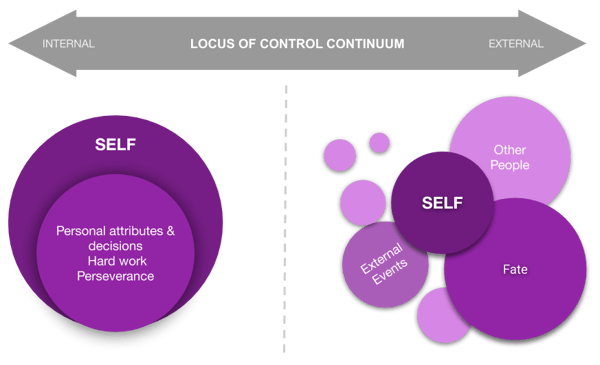 Individuals with an internal LOC learned more than did individuals with an external LOC. The difference in the learning performance levels was thought to be because an individual with an internal LOC believed they had more control over their outcomes and thus worked harder during the training to achieve their desired outcomes.
Individuals with an internal LOC learned more than did individuals with an external LOC. The difference in the learning performance levels was thought to be because an individual with an internal LOC believed they had more control over their outcomes and thus worked harder during the training to achieve their desired outcomes. 